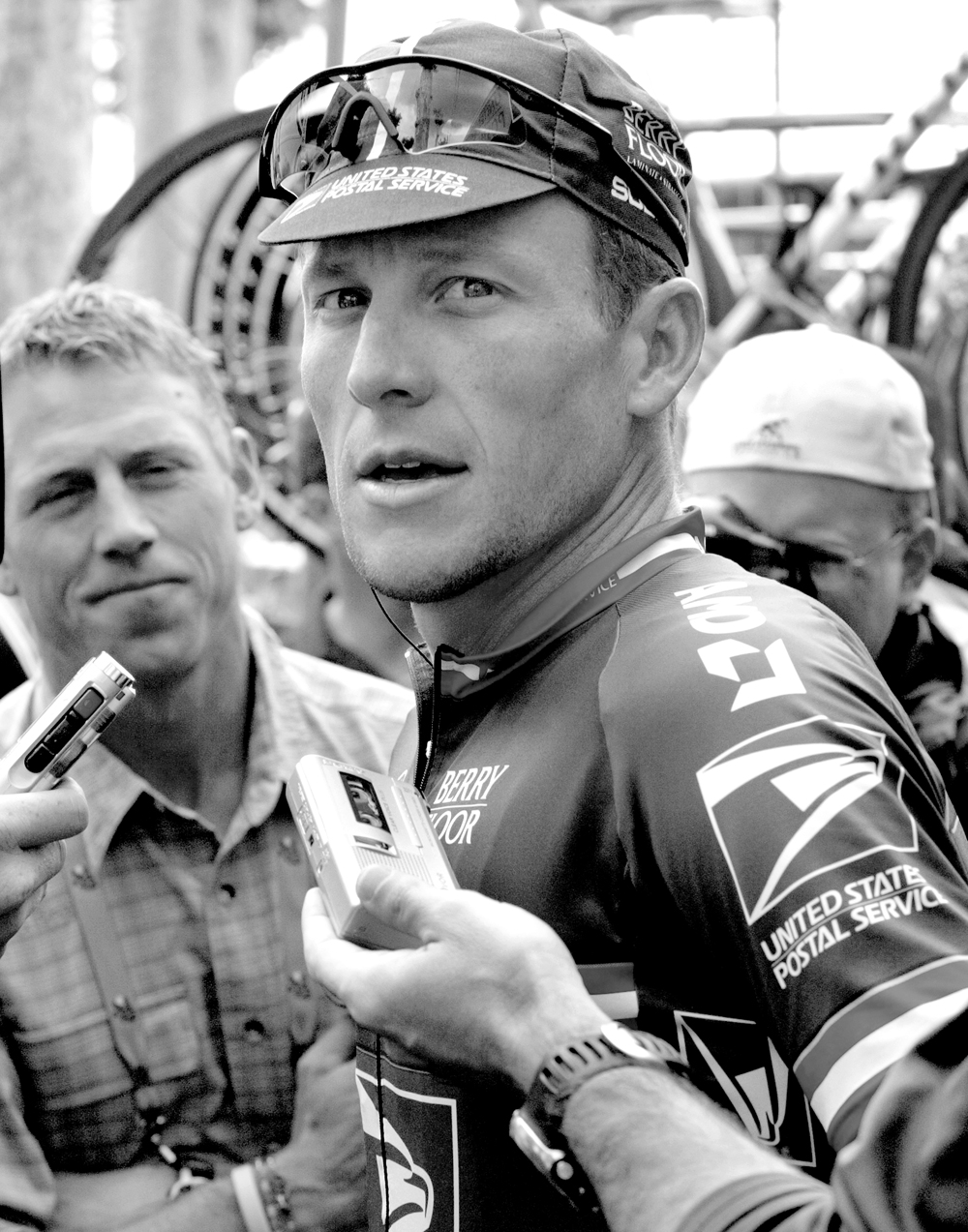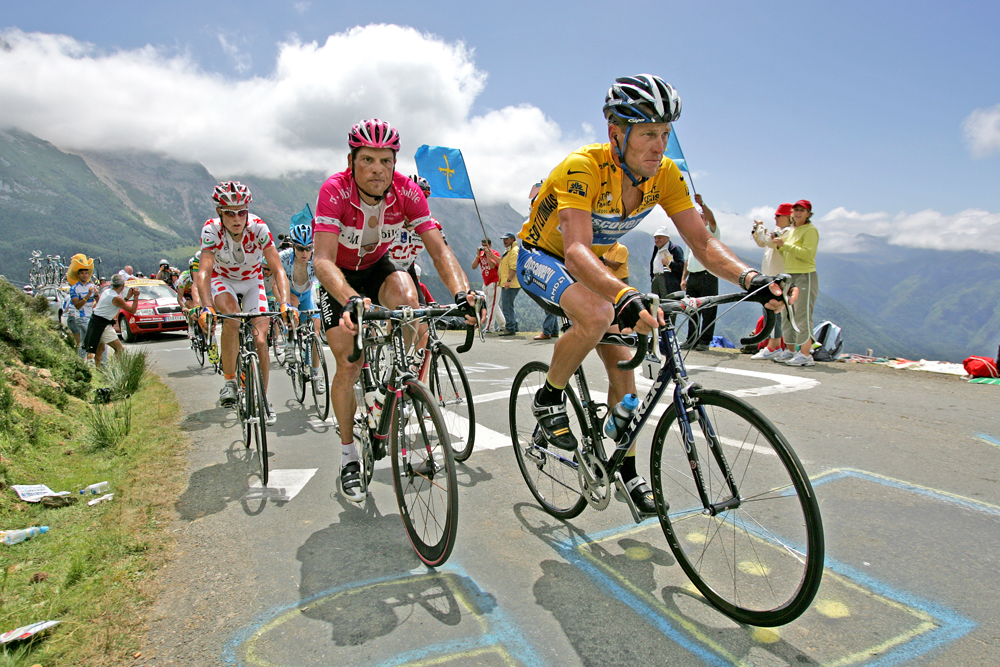By Don Scheese — Why another film about Lance Armstrong?
Since Armstrong’s fall from grace in 2012 there have been a number of films, mostly documentaries (The Armstrong Lie, Lance Armstrong: Stop At Nothing, The World According to Lance), and one fictional treatment (The Program). So, what new details and perspective could possibly be provided in such a short period of time?

The answer may lie in the latest tour Armstrong has embarked upon: a Tour of Redemption. As ESPN writer Bonnie Ford stated in this 30 for 30 documentary directed by Emmy award winning Marina Zenovich, “Lance always tries to shape the narrative about him.”
Since confessing to doping in 2013 in his infamous interview with Oprah, Lance Armstrong has been literally traveling the globe apologizing to various people whom he wronged over the years: former soigneur of US Postal Service Cycling Team Emma O’Reilly, former racer Filippo Simeoni, former teammate Frankie Andreu and his wife Betsy, among others.
And as an indicator of the success of Armstrong’s attempted recovery from disgrace, during last year’s 2019 Tour de France, NBC Sports invited him on air as an occasional guest commentator during its coverage.
Furthermore, he has launched a pair of popular podcasts, one called The Forward, in which he interviews a variety of personalities from world of politics, entertainment, art, business, sport and more, and another called THEMOVE, in which Armstrong, along with former teammate George Hincapie, and occasionally former director Johan Bruyneel talk cycling & other issues—more proof that his stock may again be on the rise in the fickle minds of the American public.
As such, this latest documentary may be—and has been perceived by some—as yet another attempt by Armstrong to revise people’s opinions about him. One thing that cannot be denied: whether loved or hated, respected or reviled, Lance Armstrong is hard to ignore.
For cycling aficionados and followers of Armstrong’s ignominious rise and fall, inevitably there is a fair amount of familiar territory covered in this documentary: the cocky youngster raised in Plano, TX by a young determined single mom; the kid no good at stick-and-ball sports who proved to be a prodigy at endurance activities like swimming, running, and cycling; the strict disciplinarian of a second father; the meteoric rise in triathlon competitions and then the professional cycling world, achieving a world championship at age 21; the miraculous cancer survivor and budding philanthropist; the Miracle Comeback Kid who went on to win seven consecutive Tours de France and became a global celebrity; the ill-fated comeback from retirement in 2009 which ironically resulted in his downfall; then the USADA investigation and now infamous confession to Oprah.
Yet one of the fascinating aspects of this most recent film are the new voices inserted into the narrative, witnesses not heard from in previous films. I was very interested to see Armstrong’s mother Linda come before the camera and talk about his upbringing; his stepfather Terry Armstrong admitting to his strict disciplinarianism and regret over not telling his adopted son he loved him enough; his former trainer Rick Crawford revealing how undisciplined and bully-like the teenage Armstrong was; his director sportif Johan Bruyneel discussing the culture of cycling and why the team could not take back Floyd in 2009 because he was “radioactive” after his getting busted for PED’s in 2006; and Armstrong’s children Luke and Grace as well as present partner Anna Hansen revealing how they felt about the doping revelations, his former girlfriends, and trials and tribulations as Armstrong’s life and lies slowly unraveled in the 2009-12 period.
Perhaps the most powerful and interesting point of view is provided by former teammate Floyd Landis, the person who more than any other was responsible for bringing down Armstrong back in 2010 when he revealed to various media outlets and authorities the shocking extent to which Armstrong and his teammates—including Landis himself—had engaged in systematic doping to win all seven Tours de France. “It’s always all about Lance,” states Landis.
Of course, familiar faces and voices are included too: Betsy Andreu, Greg LeMond, Tyler Hamilton, Christian Vandevelde, George Hincapie, Emma O’Reilly. These folks do not add to so much as repeat and reconfirm already established facts and insights into Armstrong’s saga and personality.
We know that he tried systematically to destroy the careers of Frankie Andreu and Greg Lemond. We know that Tyler Hamilton readily participated in the sophisticated doping program of US Postal, before becoming a key rival.
We know that Armstrong went into “full-on denial” when confronted with the investigations first by Jeff Novitsky of the FDA, then Travis Tygart of USADA, and subsequently went into a deep venomous funk after suffering his “tragic” fall from grace and stardom.
And we know that Armstrong, in typical “Attack Mode,” slandered Emma O’Reilly by calling her a “whore” after her tenure as one of the team’s soigneurs during the glory years—one of the actions he most regrets, he reveals to the director, when she asks “What’s the worst thing you ever did.”
This is one in a series of revelations that occurs during the documentary. In Armstrong’s attempt to tell, “not the whole truth, but My Truth,” as he says at the outset (italics mine), he unapologetically proclaims, after his near-death experience with testicular cancer, that no, it wasn’t hard to take EPO again because EPO is “one of the safer drugs you can inject into your body.” Or that, despite all his lies, denials, and counterattacks against those who dared tell the truth about his doping, he has “no problem looking into the mirror every morning” and that he “wouldn’t change a thing” about his fall—because from it he emerged a better person, more humbled and forgiving, as a result.

Supposed proof of this New Lance comes near the end of the 2-part documentary when he discusses his relationship with his greatest competitor during his 7-Tour run, the German cyclist Jan Ullrich. Armstrong visits him in Europe after Ullrich experiences his own tragic fall from grace: his doping bust in 2006 as part of Operation Puerto, his subsequent confession to using PEDs during his career, his marriage breakup and failed fatherhood, his consorting with prostitutes and arrest for violence to women, and his own attempt at recovery. Armstrong actually tears up and reveals that “I love him” when referring to Ullrich’s situation, perhaps seeing his own fall echoed in his former rival’s life and fate.
Then comes for me what I find the most telling moment of the entire film. In a series of flawed comparisons, Armstrong asks rhetorically, “Why does Italy glorify [former doper] Ivan Basso, yet disgrace [1998 Tour winner] Marco Pantani? Why does Germany idolize [former doper] Erik Zabel but disgrace and destroy Jan Ullrich? And why does America idolize George Hincapie but disgrace and destroy me?”
If Armstrong cannot honestly answer those questions, then I have to wonder: how much has he really changed, to what extent has he really been transformed?
“I could be Floyd Landis, waking up a piece of shit every day,” he says earlier in the film. “There will never be a relationship with Floyd Landis,” he states when asked if he has reconciled with his former teammate. “He is not forgivable.” But all Landis did was (eventually) tell the truth. Granted, he did it out of revenge, for being blackballed in a sport he felt was hypocritical and that had betrayed him.
If Armstrong is indeed grateful that he was brought down and became a changed man, then why wouldn’t he be able to forgive the person most responsible for his downfall? If it’s because he thinks Landis is a rat for snitching on him, what about Tyler Hamilton’s allegation that Armstrong, in a fit of jealousy and competitive rage, ratted him out to the UCI for doping when Hamilton beat him in the time trials at the 2004 Critérium du Dauphine Libéré?
Just like the Old Lance, the New Lance appears to believe there are two sets of rules: one for him, the other for the rest of the world.
I think that while this latest treatment of the greatest fall from grace in the history of sport has its merits, it fails to ask the really tough questions. After an introductory anecdote supposedly revealing, in his own words, the New Lance, the director opens with the same question to Armstrong, Hincapie, and Dave Zabriskie, “When did you start doping?” All are a bit taken aback by the seemingly blunt hard question right at the outset of each of their interviews.
But from then on, Armstrong does what he does best: shape the narrative.
Note: LANCE can be live streamed on ESPN+.
Don “Seldom Seen” Scheese lives and rides in New Mexico, always in search of new adventurous routes, especially on gravel roads.








